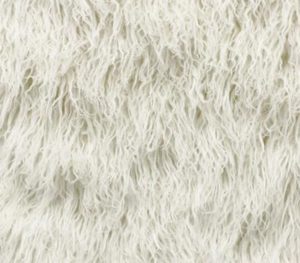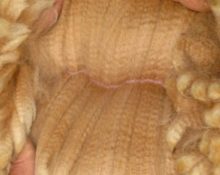The highlands of the Peruvian Andes are home to very smart and cute animals - alpacas. They are bred to produce wool with unique properties, which is the most expensive of all known types of wool fibers. What kind of animal is this and why its fur is so expensive, read on.
What kind of animal is an alpaca?
 Alpacas are domesticated animals belonging to the order of artiodactyls of the camelid family. Their height is just over a meter, and their average weight is 70 kg. They have a fairly meek disposition, are smart, inquisitive, but shy and timid.. The value is the soft long fleece, reaching 20 cm on the sides. The wool is sheared annually. Up to 3.5 kg of soft, fluffy fibers are cut from one adult individual.
Alpacas are domesticated animals belonging to the order of artiodactyls of the camelid family. Their height is just over a meter, and their average weight is 70 kg. They have a fairly meek disposition, are smart, inquisitive, but shy and timid.. The value is the soft long fleece, reaching 20 cm on the sides. The wool is sheared annually. Up to 3.5 kg of soft, fluffy fibers are cut from one adult individual.
These animals are bred in the Andes highlands in South America. The alpaca population numbers about three million animals, living mostly in Peru, but also in the mountain belts of other neighboring countries: Ecuador, Chile, Bolivia.
Properties and types of alpaca wool
Mountain nature with the scorching sun, high concentration of ultraviolet rays, constant temperature changes from heat during the day to piercing cold at night has created animals that have wool with unique properties.
Alpaca wool fabrics and yarns have many valuable qualities:
 silkiness and uniformity of the fiber structure, which remains throughout the entire life of the product;
silkiness and uniformity of the fiber structure, which remains throughout the entire life of the product;- a soft, noble glow that does not fade with time and washing;
- a pleasant soft texture that is not itchy and does not require a lining for woolen clothing or a bottom layer of long-sleeved cotton T-shirt;
- unique thermoregulatory properties - the ability to preserve heat and cold equally. In such clothes a person will not freeze in cold weather, but he will also not be hot in the summer;
- high strength and wear resistance: alpaca socks can be worn for a long time without “trampling”, and sweaters without wiping your elbows;
- hypoallergenic, due to which products from such wool can be knitted for everyone, even infants;
- the ability to repel moisture and dirt, which rolls off without attaching to the fibers.
Important! This wool has no guard hairs, and the smooth fibers do not contain lanolin. That is why alpaca wool is hypoallergenic and is not of interest to dust mites.
Alpaca fleece is represented by sinuous or bent fibers only at the very end, the thickness of which is comparable only to cashmere fluff. Animals of different ages produce the following types of wool, where the main distinguishing feature is the thickness of the fibers:
- royal - 19 microns;
- baby alpaca - 22.5 microns;
- very soft – 25.5 microns;
- adult – 32 microns.
Important! The softest, most pleasant, high-quality, and therefore most expensive is considered to be baby alpaca, obtained from the first shearing of very young animals.
Alpaca is divided into two varieties: Huacaya and Suri. Animals of the Huacaya breed are the most numerous, they make up 95% of the total livestock, and the Suri is the rarest and most valuable breed. Its raw materials are twice as expensive as Huacaya fleece, the fibers are longer, thinner, with light curls at the ends. If the baby yarn is based on the Suri breed, then the result is the highest quality and most expensive wool in the world - Suri baby alpaca.
How is it produced?
 After shearing, the melange fibers are manually sorted, distributing the raw materials according to natural shades, of which there are up to 24 in animals of this species - from silver and snow-white to jet black. This is painstaking and tedious work, which also further increases the cost of the resulting material.
After shearing, the melange fibers are manually sorted, distributing the raw materials according to natural shades, of which there are up to 24 in animals of this species - from silver and snow-white to jet black. This is painstaking and tedious work, which also further increases the cost of the resulting material.
After sorting, impurities of dirt and plant residues are removed from the raw materials, then the wool is spun, washed, removing residual sand and fat, and, if necessary, dyed. After such processing, the raw materials do not lose their quality for a long time.
Where is this wool used?
 This animal has been known to mankind for more than 6 thousand years. Even the ancient Incas bred alpacas to produce valuable wool of unique color shades and the highest quality. Only representatives of the royal family and the ruling elite could afford such luxurious clothes.
This animal has been known to mankind for more than 6 thousand years. Even the ancient Incas bred alpacas to produce valuable wool of unique color shades and the highest quality. Only representatives of the royal family and the ruling elite could afford such luxurious clothes.
Now products made from alpaca are not the privilege of royal dynasties; anyone can afford to buy clothes or a blanket made from expensive fiber. Needlewomen often purchase yarn consisting of wool or blends containing alpaca.
The wool of these animals is used to produce the following products:
- sweaters, cardigans, jackets, pullovers;
- scarves, caps, hats;
- socks;
- coats and jackets;
- dresses, jackets, suits;
- carpets, rugs.
The raw material sheared from young animals is used for the production of costume and dress fabrics, and the fleece of mature animals is used for rugs and carpets.
Pros and cons of yarn
No other type of wool has similar qualities, and therefore alpaca is very popular among needlewomen. In addition to all that has been said, we note a number of positive aspects of this fiber:
 The absence of a scaly structure on the surface of the villi, which ensures comfort in using the products even without lining;
The absence of a scaly structure on the surface of the villi, which ensures comfort in using the products even without lining;- lightness, strength, resistance to stretching and shrinkage;
- wool does not have a memory effect, and therefore remains in its original form for a long time;
- Alpaca items do not roll or fall off.
The only downside that can be noted is the high cost of the material, but mixed compositions of yarn or textiles with other types of natural wool, acrylic, polyamide, viscose can significantly reduce the cost while maintaining the basic qualities and attractiveness.
What are the differences between sheep wool and llama wool?
Alpaca wool is lighter than sheep wool, but its fibers are three times stronger, and the products are several times warmer;
 does not have a characteristic unpleasant odor, like raw materials from sheep;
does not have a characteristic unpleasant odor, like raw materials from sheep;- alpacas are sheared only once a year, and many sheep are sheared twice;
- The llama's wool is coarser and stiffer, while that of the suri and huacaya is soft, but very dense;
- alpaca fiber is almost completely waterproof and somewhat dirt-repellent;
- it has many color variations, so dyeing is rarely used.
How to care for her?
Products should be washed using special products in water at room temperature. It is recommended not to wring out the items, but to allow the water to drain, and only then lay them out on a horizontal surface, aligning the seams and sleeves.
Important! To maintain alpaca items in proper condition, they are washed after six to seven wears and always by hand.
Clothes made from delicate fibers should be ironed using a damp cloth at low temperatures.. It is easy to restore the pile by simply running a brush along the outside. Such things should be stored with sprigs of lavender, cedar or tobacco instead of aggressive moth repellents.


 silkiness and uniformity of the fiber structure, which remains throughout the entire life of the product;
silkiness and uniformity of the fiber structure, which remains throughout the entire life of the product; The absence of a scaly structure on the surface of the villi, which ensures comfort in using the products even without lining;
The absence of a scaly structure on the surface of the villi, which ensures comfort in using the products even without lining; does not have a characteristic unpleasant odor, like raw materials from sheep;
does not have a characteristic unpleasant odor, like raw materials from sheep; 0
0





